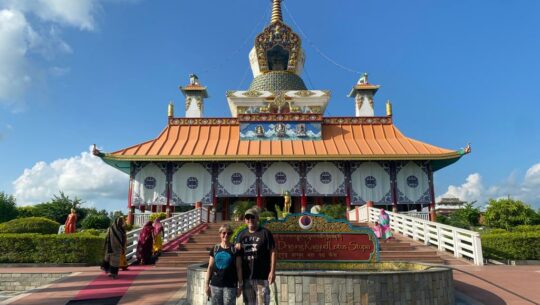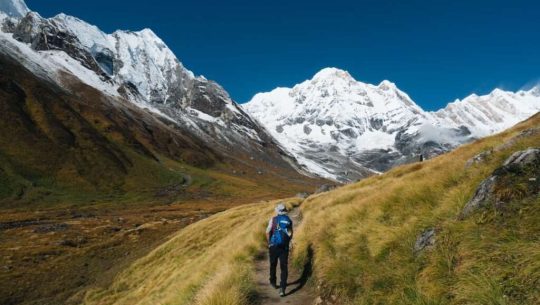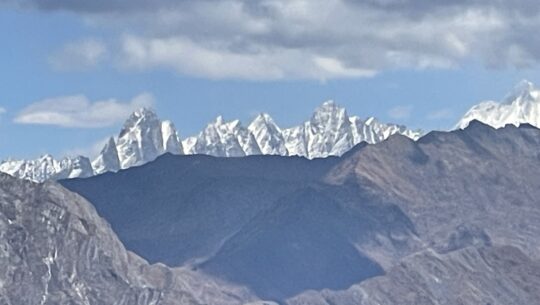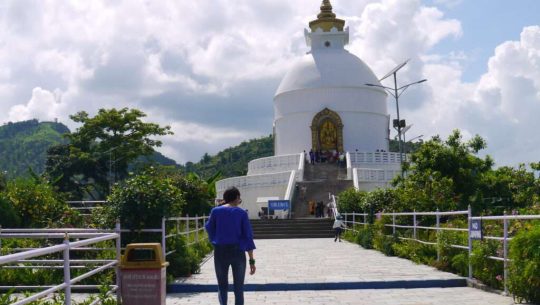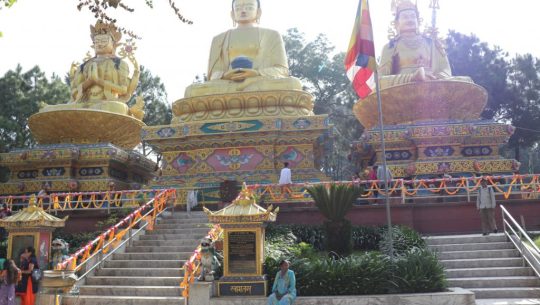International Relations for Tourism Development in Himawat Khanda
Abstract
Nepal, known as the center of “Himawat Khanda,” is celebrated for its rich cultural heritage, breathtaking landscapes, and role as the gateway to the Himalayas. This research examines how international relations can catalyze sustainable tourism development in Nepal. It investigates the interplay between diplomatic partnerships, global collaborations, and tourism policies to explore opportunities and challenges in promoting Nepal as a premier global tourism destination.
The study adopts a multidisciplinary approach, integrating international relations and sustainable tourism theories, and employs mixed methods, including primary interviews and secondary data analysis. Key findings underscore the significance of diplomatic missions, foreign direct investment, cultural diplomacy, and international cooperation in enhancing Nepal’s tourism potential. The research also highlights geopolitical challenges and the need for sustainable practices to safeguard the fragile Himalayan ecosystem.
Recommendations include diversifying source markets, streamlining visa processes, fostering public-private partnerships, enhancing capacity building, and prioritizing environmental conservation. By leveraging international relations and adopting strategic policies, Nepal can position itself as a global leader in sustainable tourism, maximizing the potential of the “Himawat Khanda” to captivate and inspire travelers worldwide.
1. Introduction
Nepal, often celebrated as the “heart of Himawat Khanda,” encompasses a significant portion of this magnificent Himalayan region. Home to towering peaks, renowned trekking trails, and an array of cultural heritage sites, Nepal serves as a global hub for tourism. The Himalayas’ cultural, environmental, and strategic significance highlights their role in fostering international relations and regional cooperation, making them a critical focus for sustainable tourism development.
The Great Himalayas stretch across multiple nations, hosting some of the world’s tallest peaks, including Nanga Parbat, Annapurna, Manaslu, Mount Everest, and Kanchenjunga. Of these, Mount Everest, the world’s highest peak, exemplifies Nepal’s geographical prominence. The Himalayas span regions of present-day some part of Russia, Pakistan, Afghanistan, the northern part of India, much of Nepal, China, Bhutan, and Myanmar. Nepal’s central position in this range underscores its vital role in promoting transnational collaboration, especially through tourism and cultural exchange initiatives.
Statement of the Problem
Tourism has long served as a lifeline for Nepal’s economy, fostering employment, cultural exchange, and generating vital foreign exchange earnings. Despite its immense potential, Nepal’s tourism industry struggles to reach its zenith, hindered by infrastructure limitations, underdeveloped international marketing strategies, and complex geopolitical dynamics.
Research Objectives
This research delves into the transformative role that international relations can play in amplifying Nepal’s global tourism footprint. It seeks to:
i. Examine the interplay of diplomatic efforts, international collaborations, and sustainable tourism practices.
ii. Chart a roadmap for Nepal’s emergence as a premier global destination.
iii. Explore how strategic alliances and policy coherence can elevate Nepal’s tourism sector.
In a world increasingly shaped by interconnectedness, the confluence of international relations and tourism development offers a compelling framework for unlocking the true potential of the “Himawat Khanda.”
2. Review of Literature
i. Theoretical Framework
The study integrates principles from international relations, sustainable tourism development, and economic growth. Dependency theory and liberal internationalism provide a nuanced understanding of Nepal’s reliance on international partnerships and the reciprocal benefits of collaborative initiatives in tourism development.
Dependency Theory:
Highlights Nepal’s economic reliance on foreign partnerships for tourism infrastructure, marketing, and capacity building.
Liberal Internationalism:
Emphasizes global cooperation, multilateralism, and shared prosperity through diplomatic engagements and cultural exchanges.
Sustainable Tourism Principles:
Align with the triple bottom line of economic, environmental, and social sustainability to address the complexities of tourism development in fragile ecosystems.
ii. Comparative Analysis
The framework incorporates comparative analysis with other mountainous regions like Bhutan and Switzerland, identifying transferable practices, such as Bhutan’s “high-value, low-volume” tourism strategy.
3. Research Methods
This research employs a robust mixed-methods approach to comprehensively examine the role of international relations in the sustainable development of Nepal’s tourism sector. By integrating qualitative and quantitative data, the methodology ensures a multidimensional analysis of the factors influencing tourism growth in the context of Nepal’s international positioning as “Himawat Khanda.”
i. Data Collection
Primary Data:
Structured and semi-structured interviews were conducted with policymakers, tourism operators, representatives from Nepal’s diplomatic missions, and international collaborators.
Focus group discussions with local community representatives and tourism professionals provided grassroots insights into the challenges and opportunities in Nepal’s tourism sector.
Secondary Data:
A comprehensive review of government reports, academic studies, policy papers, and global tourism statistics established a foundational understanding of Nepal’s tourism industry. Key sources included the United Nations World Tourism Organization (UNWTO) guidelines and the annual report from Nepal’s Ministry of Tourism.
ii. Comparative Analysis
The study included a comparative analysis of tourism strategies from other mountainous regions with similar geopolitical or ecological contexts, such as Bhutan, Switzerland, and Peru. This helped identify adaptable models and best practices for Nepal’s tourism development.
iii. Theoretical Framework Integration
The research integrates two key theoretical frameworks:
Dependency Theory:
To assess Nepal’s reliance on foreign partnerships for tourism development and the implications for economic independence.
Liberal Internationalism:
To evaluate the mutual benefits of collaborative international relations and multilateral agreements in advancing tourism growth.
iv. Sustainability Focus
The study emphasized the role of international organizations, such as UNDP and UNWTO, in promoting environmentally conscious tourism practices. Projects in ecologically sensitive areas were evaluated to balance economic growth with conservation goals.
v. Data Analysis
Qualitative Data:
Thematic coding was applied to interview and focus group data to identify recurring patterns and insights.
Quantitative Data:
Statistical analysis was conducted on trends in tourist arrivals, foreign direct investments, and revenue generation over the past decade.
Comparative Metrics:
Benchmarking against global destinations provided context and identified areas for improvement.
This methodological approach ensures a comprehensive exploration of how international relations can act as a catalyst for sustainable tourism development in Nepal, with a focus on balancing economic growth, cultural promotion, and environmental conservation.
4. Data Analysis and Discussion
Data Analysis
Diplomatic Partnerships and Tourism Promotion
Nepal’s diplomatic missions have been pivotal in promoting its tourism industry globally through collaborations and cultural events. However, the focus on traditional markets limits growth. Expanding to emerging markets in the Middle East and Southeast Asia, along with improved staff training and digital marketing, can diversify the tourist base.
Foreign Investment in Tourism Infrastructure
Foreign direct investment has significantly enhanced Nepal’s tourism infrastructure, including airport expansions and luxury accommodations. Addressing bureaucratic inefficiencies and fostering public-private partnerships can accelerate development and attract more investments.
Cultural Diplomacy and Soft Power
Nepal’s rich cultural heritage forms the basis of its soft power. Initiatives showcasing art and traditions have boosted its global image. A unified branding strategy and better coordination can amplify these efforts.
Geopolitical Dynamics
Nepal’s strategic location between India and China offers opportunities for trilateral tourism and regional connectivity. Balancing neutrality and fostering regional collaboration are key to leveraging this position.
Sustainability Through International Cooperation
Partnerships with global organizations have advanced sustainable tourism, but enforcement of conservation laws remains weak. Strengthening legal frameworks and community involvement can protect Nepal’s ecosystem.
Comparative Analysis of Global Practices
Learning from Bhutan’s exclusive tourism model and Switzerland’s transport systems can help Nepal enhance its competitiveness by adapting these practices to its unique context.
Quantitative Insights
Tourism statistics reveal consistent growth in arrivals and revenue, but challenges like seasonal fluctuations and regional disparities persist. Diversifying offerings, such as wellness retreats and adventure tourism, can ensure equitable development.
Key Themes from Qualitative Data
Community Involvement: Inclusive policies for local participation are essential.
Capacity Building: Training programs can improve service quality.
Environmental Concerns: Balancing growth with ecological preservation is crucial.
Discussion
International relations significantly contribute to Nepal’s tourism sector. Diplomatic partnerships, investments, and multilateral cooperation have delivered notable benefits, but inefficiencies in policies and geopolitical tensions pose challenges. A strategic, sustainability-focused approach can transform Nepal into a leading global destination while ensuring resilience across economic, cultural, and environmental dimensions.
5. Conclusion and Implications
Conclusion
Nepal’s tourism potential lies in its natural beauty, cultural richness, and strategic location. Diplomatic efforts, investments, and cultural diplomacy play critical roles, but addressing challenges like infrastructure gaps and geopolitical complexities is essential. Diversification, improved visa processes, and conservation efforts can balance growth with sustainability.
Implications
Economic Growth: Tourism expansion can boost revenue, create jobs, and reduce dependency on remittances.
Environmental Conservation: Strict conservation laws and eco-tourism can protect Nepal’s fragile ecosystem.
Cultural Preservation: Unified branding can enhance global visibility and cultural pride.
Geopolitical Stability: Regional collaboration can mitigate risks and foster a stable environment for tourism.
By integrating strategic policies and sustainability, Nepal can position itself as a model for sustainable tourism and a premier global destination.
References
Banjara, K. (2025). Visit Nepal “Encyclopedia of Himawat Khanda.” Kathmandu: Buddha Publication.
Government of Nepal, Ministry of Tourism and Civil Aviation. (2023). Annual Tourism Report. Kathmandu: Government Press.
Thapa, K. (2020). “Cultural Diplomacy and Nepal’s Tourism Potential.” Journal of Himalayan Studies.
United Nations World Tourism Organization (UNWTO). (2022). Sustainable Tourism Guidelines. Madrid: UNWTO.
World Bank. (2023). Nepal Country Economic Memorandum: Unlocking Growth through Tourism. Washington, D.C.: The World Bank.

